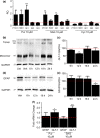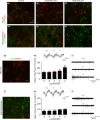Sonic hedgehog signalling mediates astrocyte crosstalk with neurons to confer neuroprotection
- PMID: 28485896
- PMCID: PMC5575469
- DOI: 10.1111/jnc.14064
Sonic hedgehog signalling mediates astrocyte crosstalk with neurons to confer neuroprotection
Abstract
Sonic hedgehog (SHH) is a glycoprotein associated with development that is also expressed in the adult CNS and released after brain injury. Since the SHH receptors patched homolog-1 and Smoothened are highly expressed on astrocytes, we hypothesized that SHH regulates astrocyte function. Primary mouse cortical astrocytes derived from embryonic Swiss mouse cortices, were treated with two chemically distinct agonists of the SHH pathway, which caused astrocytes to elongate and proliferate. These changes are accompanied by decreases in the major astrocyte glutamate transporter-1 and the astrocyte intermediate filament protein glial fibrillary acidic protein. Multisite electrophysiological recordings revealed that the SHH agonist, smoothened agonist suppressed neuronal firing in astrocyte-neuron co-cultures and this was abolished by the astrocyte metabolic inhibitor ethylfluoroacetate, revealing that SHH stimulation of metabolically active astrocytes influences neuronal firing. Using three-dimensional co-culture, MAP2 western blotting and immunohistochemistry, we show that SHH-stimulated astrocytes protect neurons from kainate-induced cell death. Altogether the results show that SHH regulation of astrocyte function represents an endogenous neuroprotective mechanism.
Keywords: Gli1; cell culture; multielectrode array; neurodegeneration.
© 2017 The Authors. Journal of Neurochemistry published by John Wiley & Sons Ltd on behalf of International Society for Neurochemistry.
Figures






Similar articles
-
Control of glial precursor cell development in the mouse optic nerve by sonic hedgehog from retinal ganglion cells.Brain Res. 2008 Sep 4;1228:27-42. doi: 10.1016/j.brainres.2008.06.058. Epub 2008 Jun 24. Brain Res. 2008. PMID: 18625210
-
Megalin mediates the influence of sonic hedgehog on oligodendrocyte precursor cell migration and proliferation during development.Glia. 2012 May;60(6):851-66. doi: 10.1002/glia.22316. Epub 2012 Feb 21. Glia. 2012. PMID: 22354480
-
Sonic Hedgehog receptor Patched deficiency in astrocytes enhances glucose metabolism in mice.Mol Metab. 2021 May;47:101172. doi: 10.1016/j.molmet.2021.101172. Epub 2021 Jan 26. Mol Metab. 2021. PMID: 33513436 Free PMC article.
-
New Tricks for an Old (Hedge)Hog: Sonic Hedgehog Regulation of Astrocyte Function.Cells. 2021 May 30;10(6):1353. doi: 10.3390/cells10061353. Cells. 2021. PMID: 34070740 Free PMC article. Review.
-
Roles of astrocytic sonic hedgehog production and its signal for regulation of the blood-brain barrier permeability.Vitam Horm. 2024;126:97-111. doi: 10.1016/bs.vh.2024.04.006. Epub 2024 May 19. Vitam Horm. 2024. PMID: 39029978 Review.
Cited by
-
Molecular mechanisms of developmental pathways in neurological disorders: a pharmacological and therapeutic review.Open Biol. 2022 Mar;12(3):210289. doi: 10.1098/rsob.210289. Epub 2022 Mar 16. Open Biol. 2022. PMID: 35291879 Free PMC article. Review.
-
The Hedgehog Signaling Pathway is Expressed in the Adult Mouse Hypothalamus and Modulated by Fasting.eNeuro. 2021 Sep 29;8(5):ENEURO.0276-21.2021. doi: 10.1523/ENEURO.0276-21.2021. Print 2021 Sep-Oct. eNeuro. 2021. PMID: 34535504 Free PMC article.
-
Prophylactic Activation of Shh Signaling Attenuates TBI-Induced Seizures in Zebrafish by Modulating Glutamate Excitotoxicity through Eaat2a.Biomedicines. 2021 Dec 24;10(1):32. doi: 10.3390/biomedicines10010032. Biomedicines. 2021. PMID: 35052712 Free PMC article.
-
Impact of thyroid hormone perturbations in adult mice: brain weight and blood vessel changes, gene expression variation, and neurobehavioral outcomes.Neurobiol Aging. 2023 Aug;128:74-84. doi: 10.1016/j.neurobiolaging.2023.04.012. Epub 2023 Apr 29. Neurobiol Aging. 2023. PMID: 37229849 Free PMC article.
-
Glia as sculptors of synaptic plasticity.Neurosci Res. 2021 Jun;167:17-29. doi: 10.1016/j.neures.2020.11.005. Epub 2020 Dec 11. Neurosci Res. 2021. PMID: 33316304 Free PMC article. Review.
References
-
- Atkinson P. J. Atkinson P. J., Dellovade T., Albers D., Von Schack D., Saraf K., Needle E., Reinhart P. H. and Hirst W. D. (2009) Sonic hedgehog signaling in astrocytes is dependent on p38 mitogen‐activated protein kinase and G‐protein receptor kinase 2. J. Neurochem. 108, 1539–1549. - PubMed
-
- Bambakidis N. C., Horn E. M., Nakaji P., et al (2009) Endogenous stem cell proliferation induced by intravenous hedgehog agonist administration after contusion in the adult rat spinal cord. Spine 10, 171–176. - PubMed
Publication types
MeSH terms
Substances
Grants and funding
LinkOut - more resources
Full Text Sources
Other Literature Sources

